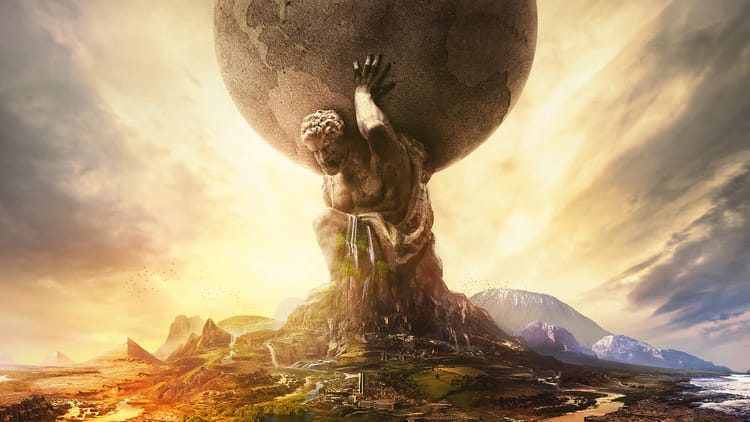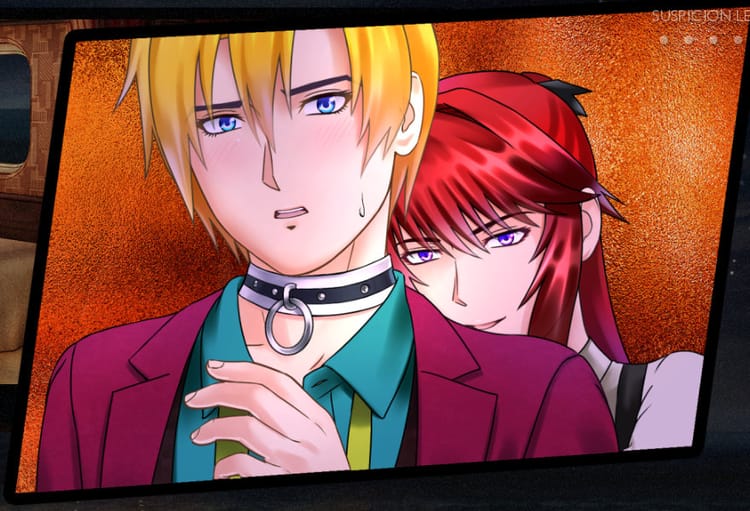The pointless scale of Xenoblade Chronicles X

For more about Kill Screen’s ratings system and review policy, click here.
A few months ago, The New York Times and several other outlets ran a story about an unlikely extinction happening in Japan: the Aibo, a robotic dog manufactured by Sony, was slowly but surely dying out. The company stopped repairing them in March 2014 due to a scarcity of spare parts, leaving Aibo owners unable to do much to resuscitate their moribund companions when technical failure eventually occurs—as it inevitably will. As a result, some owners are already holding Aibo funerals, mourning the loss of an object that received as much emotional investment as any flesh-and-blood canine. As the officiant at one of these funerals, captured on video by the Times, intoned, “The inanimate and the animate are not separated in this world. We have to look deeper to see this connection.”
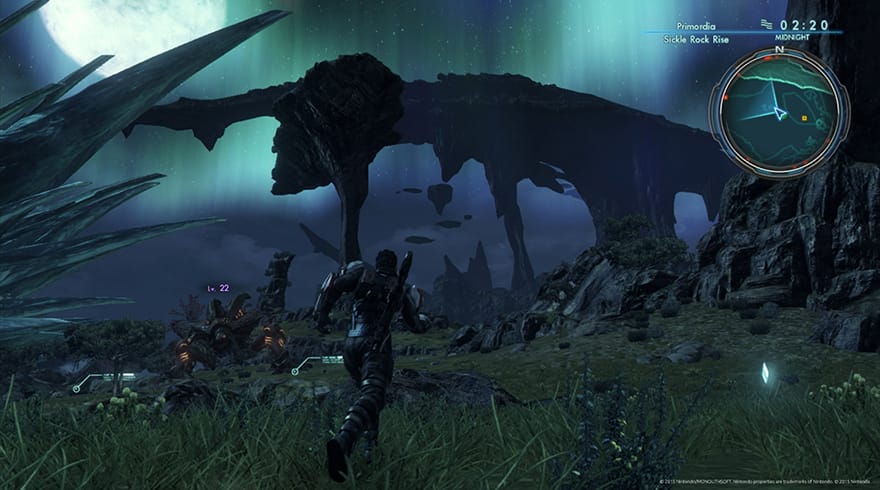
Has Tetsuya Takahashi ever owned an Aibo? His games make me wonder, because they seem hell-bent on examining—and in a lot of ways, dissolving—the philosophical boundaries that intercross at a funeral for a robot dog: boundaries between the inanimate and the animate, the organic and the synthetic, the familiar and the alien, the physical and the spiritual. His career in JRPGs began with his designs for the Magitek armor in Final Fantasy VI, marking the series’ first flirtation not only with sci-fi but with the idea of a human-machine interface that called humanity itself into question. After that, he took the reins and directed Xenogears, a sprawling, philosophically ambitious JRPG about humans, robots, and God; then Xenosaga, a sprawling, philosophically overambitious three-part saga—it was supposed to be six—about humans, robots, and God; then Xenoblade Chronicles, a game of beautiful and surprising restraint that neatly allegorized the same big questions about … well, you get the idea. In Xenoblade Chronicles, you play as dwellers of the Bionis, an organic titan frozen in perpetual conflict with his robot nemesis, Mechonis. The Mechon are your enemy. And yet, some of them have faces. Some of them have human voices—albeit angry Cockney ones. Could it be that this elemental conflict between flesh and metal isn’t as elemental as it seems?
Xenoblade Chronicles was a triumph, but it was also always going to be an exception: a JRPG crafted for accessibility at a moment in the genre’s history when it, too, like the Aibo, might’ve seemed like a fetish object with a cult following whose days were numbered. The game worked. The story was as simple and complex as a fairytale; the systems were traditional yet reformist, distilling everything that makes JRPGs feel so alive despite their studious, often baffling artificiality. The translation of basic party strategy into impossible, flamboyant combos. The feeling of exponential—not linear—development: at level 1, you’re fighting crabs; at level 70, you’re fighting God. The essence of the horizon: to not know exactly where you’re going, and to be thrilled when there’s another place to go.
Xenoblade Chronicles X is big
Xenoblade Chronicles X retains almost none of that. The game is in every single way a disappointment. And maybe it’s unfair to compare it to its “spiritual predecessor” when that predecessor was so self-consciously exceptional in the first place. The game is a lot more like the worst parts of Xenogears and Xenosaga: overambitious and therefore incomplete; addicted to clunky, interminable exposition rather than the (relatively) subtler medium of capital-A Allegory; geared toward placating only the most veteran JRPG players rather than serving as an ambassador for the genre to everyone else. At the same time, I think its greatest failure has more to do with the big themes that bind together all of Takahashi’s games, Xenoblade Chronicles included. Everything about it is so synthetic that it has no possible way of being organic.
Xenoblade Chronicles X is big. You’ve probably heard that already. The game takes place on the planet Mira, where humans aboard a giant ship named the White Whale—like MGSV, the game is strangely preoccupied with Moby-Dick—have crash-landed after fleeing the destruction of Earth. Your task is simple: find the Lifehold, the part of the ship that contains the majority of its human population in stasis. The White Whale itself was pretty big, but Mira is bigger, comprising five huge, freely explorable areas with different climates that the game wants you to think of as continents. There’s Primordia, which is like a radically expanded version of Xenoblade Chronicles’ Gaur Plain; there’s Noctilum, a bioluminescent megaforest ripped straight out of Avatar (like many of the game’s fauna, which look like gross, lizardy alien versions of Earth animals, and also like a few of its characters: Vandham, the game’s gruff commander figure, is essentially a nicer version of Stephen Lang’s mech-suited imperialist asshole). Oblivia is perhaps the most captivating environment, a desert landscape punctured by the enormous wreckage of ancient alien ships, which become mountains in themselves. Much of the game—scratch that: the game’s essence—is about exploring these stark, concept-art wonderlands, first on foot, then in a mech-suit (“Skell”) that doubles as a car. And then by air.
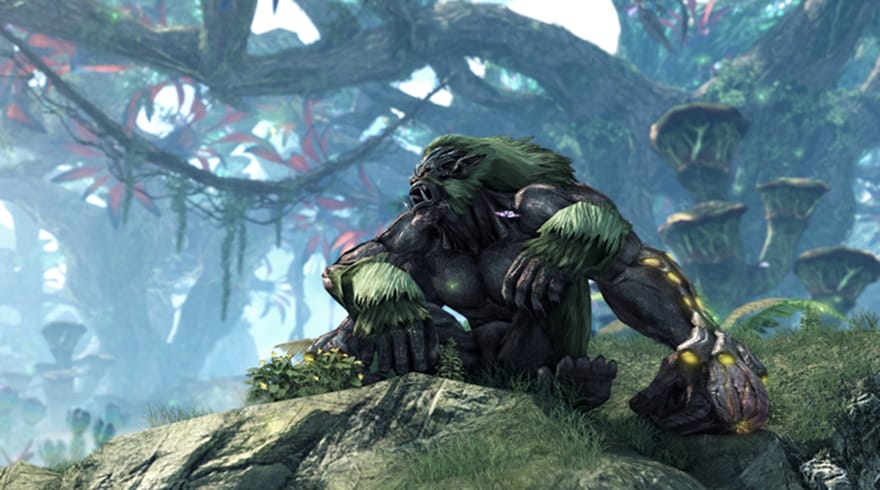
The game provides proof of its own concept the first time you fly directly, seamlessly, from the streets of New Los Angeles (the game’s only human colony) to the highest peak in Primordia, high above the lakes and plains where the bizarro brontosauruses roam. It really is an amazing update to the airship in RPGs of old, or the heavenly wings in Dragon Quest VIII—that moment when you finally master the scale of the world, after struggling in the beginning to walk across a fragment. (In that respect, given genre tradition, the fact that you only get the ability to fly around 40 hours into the game makes sense.) Unfortunately, the sublimity of that moment is shadowed by the ever-present sense that it really is the game’s point, pursued with monomaniacal, Ahab-like fixation. Xenoblade Chronicles X is a game of great scale. But scale means nothing when it’s pursued for the sake of scale.
The game might be “big” in a literal sense, but it feels very small in a conceptual and emotional sense. Part of the reason is that you can traverse it at great speed, effortlessly and weightlessly, like some sort of hyperactive space squirrel: it doesn’t really matter that you’re crossing a plain that’s five miles wide if you can run at 60 miles per hour. But the other problem is the GamePad, and everything it represents. You’re always holding a map screen that not only tells you a lot about the five continents from the get-go (including where they are, what environmental theme each one falls into, and what kind of enemies to expect), but divides the world into a rigid grid of hexagons. Place more “data probes” in each area, and the hexagons will fill themselves with potential tasks: kill a giant monster here; find a treasure there. Each area map prominently features a percentage counter that records, to a double-decimel, the completeness of your “survey” (which means not just how much stuff you’ve found but how many sidequests you’ve done). For a game explicitly about exploration, its world feels profoundly pre-explored. Even worse, it turns exploration itself—ostensibly all about encountering the unknown—into systematic busywork that revolves around a literal checklist.
For a game explicitly about exploration, its world feels profoundly pre-explored.
Final Fantasy XIII’s Pulse, that wide-open area at the end of a game so notorious for its stifling linearity, “felt” bigger than anything you can traverse here—in part because, in that classic JRPG move, it was a space that wasn’t available at the beginning of the game, a suddenly and dramatically expanded horizon. Think of the bigness of the overworld after 10 hours spent in the streets of Midgar. Think of a world with one continent suddenly becoming a world with four in Final Fantasy IX—that quintessential example of the JRPG’s Magellan effect. There’s nothing dramatic about the scale of things in Xenoblade Chronicles X—nothing revelatory, nothing sudden or strange. You’re not really exploring. At most, you’re collecting, through the mediating screen-door of the GamePad’s insistent clutter: this vista and then that one; this cave, this promontory, this rock. And it’s all empty, depopulated, unsatisfying—including New Los Angeles itself.
That still wouldn’t be a huge problem if the game had a narrative that transcended its busywork structure, but it doesn’t: the story is simply one giant, prolonged exploratory task, interwoven into the web of tasks you’re doing already. Why do we need to look for the Lifehold? Because Mira is so big! What do we need to do to find the Lifehold? Explore more of Mira, because it is so big! Every single thing in the game is rooted in the same obsession with sheer expansiveness—the same misguided ethos that seems to believe that expansiveness is a virtue in itself (No Man’s Sky, take note). On the level of battles, gear, and stats, this ethos manifests as infuriating abstruseness—a tendency to add systems on top of systems, complexity for the sake of complexity. The battle system is a cluttered mess; as a testament to its redundancies, consider the fact that your HP appears in two places on the already-crowded screen. Things do eventually click; if you’re like me, you’ll feel hugely satisfied when you “get it,” in the same way it feels good to untangle a giant ball of Ethernet cables and AC adapters.
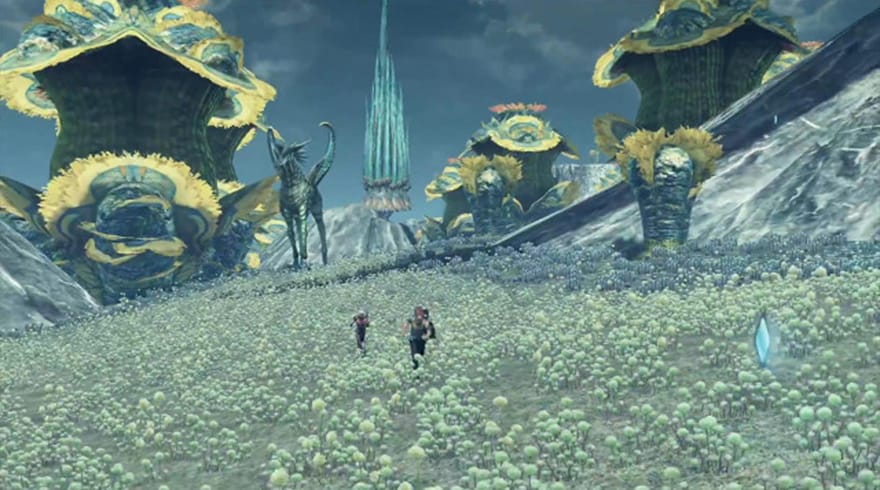
But a lot of the complexity feels not only pointless but actively oppositional, as though indirectness were also a virtue in itself. As you plant more data probes, they start to yield “Miranium,” a resource that can be used to invest in arms manufacturers—another system, apparently borrowed from Borderlands—which will then eventually produce better gear. Every half hour, you receive more Miranium from your precious probes, until you reach a cap that can only be increased by “storage probes,” at which point you have to return to NLA and invest your stockpiled Miranium. You cannot buy storage probes, despite the mundanity of their function; you can only find them or receive them as quest rewards. In practice, all they do is stifle you. Why do they even exist? Why not uncap the amount of Miranium you can mine every half hour—isn’t time already a limiting factor?—so that you don’t have to return to NLA over and over again? There’s only one answer: because having another kind of probe in the game means having more of something.
Here’s another example of needless, obstructive addition. Xenoblade Chronicles streamlined standard JRPG practice for the better by reviving dead parties almost instantaneously at the last landmark they visited—or, in a boss fight, nearby. Xenoblade Chronicles X does the same thing when your party dies on the ground. But if anyone dies in a Skell, a whole set of brand-new systems come into play. The Skell is destroyed, which means you have to go back to NLA to salvage it. In the best case scenario, you pay nothing because you still have “Skell insurance.” In the worst case scenario, you pay hundreds of thousands of hard-earned credits to gain back the Skell you already paid for—in a game that makes dying in a Skell about as easy as dying outside one, depending on the creatures you try to fight (or the creatures that decide to fight you, because you were in the wrong place at the wrong time in a game about … exploration).
It ought to remind us of what’s so good about the maximalism of other JRPGs
All JRPGs have bullshit like this in some form. The best ones find some way to coat their bullshit—the grinding, the fetch quests, the arcane systems—with a sense of epic urgency, or an atmosphere of against-the-odds oppression. The best Xenoblade Chronicles X can do in this regard, on the level of ludo-narrative continuity, is to remind you of your own insignificance: Skells are expensive, “storage probes” are prohibitive, Mira is already half-charted, because you are just a random human on NLA’s payroll, working toward a project that transcends you, a project on a greater scale than the individual self. Unlike its predecessor, which centered (like so many JRPGs) on a teenage messiah chosen by the divine, Xenoblade Chronicles X takes great pains to remind your customized avatar that he’s only one member of one team in one section of an eight-division organization called BLADE—an organization in which you can choose to be a monster hunter just as well as a miner, a social worker for NPCs, or a collector of little plants and alien garbage. In Star Wars Galaxies, it was interesting and cool that you could be a Jedi as well as a bartender. But there were other people in Star Wars Galaxies. Here, for all the game’s attempts to mimic MMOs, the multiplayer is mostly asynchronous—and besides, your division does almost nothing to determine what you actually do. The game’s pervasive anti-individualism is definitely something different, but it derives from the same obsession with scale that seems to have informed every other aesthetic, narrative, and design decision. BLADE has eight divisions because it wouldn’t feel big enough with four.
Where exactly did this obsession come from? It seems simultaneously rooted in a desire for realism—as in a game environment built “to scale”—and a desire to transcend realism, to be bigger than life. It accomplishes neither. If anything, the one thing it does accomplish is to remind us of the folly of maximalism for the sake of maximalism in games, where it’s an all-too-prevalent design philosophy that steals resources, and the spotlight, from other forms of aesthetic ambition. It reminds us of the same problem in any other medium, from panoramic triple-decker novels that assume that panorama itself is a virtue to three-hour superhero movies (or expanding cinematic universes) crammed with characters. And I think it ought to remind us of what’s so good about the maximalism of other JRPGs, Takahashi’s included, which always go big but seldom assume so blithely that size is everything.
The best JRPGs transform the synthetic into the organic, somehow creating pathos through artificiality and yoking abstract systems—repetition, machinelike behavioral loops—to melodrama. The best JRPGs have the potential to teach us a lot about precisely the things that seem to preoccupy Takahashi in game after game: the humanity of the inhuman, from objects to robots to videogames themselves; the inhumanity of what we tend to call human, given that the human self always seems to rely on things outside it, things unlike it, to give itself form, definition, and weight. This JRPG asks us to do nothing except buy into its synthetic religion of scale. You are big, Xenoblade Chronicles X. You are big because big is good. It’s like stroking a dead Aibo—an Aibo that was never alive in the first place.
For more about Kill Screen’s ratings system and review policy, click here.


